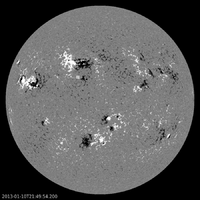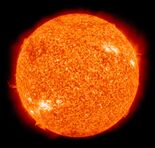Astronomy:Hale's law
In solar physics, Hale's law, also known as Hale's polarity law or the Hale–Nicholson law, is an empirical law for the orientation of magnetic fields in solar active regions. It applies to simple active regions that have bipolar magnetic field configurations where one magnetic polarity is leading with respect to the direction of solar rotation. Hale's law states that, in the same northern or southern solar hemisphere, such active regions have the same leading magnetic polarity; that, in opposite hemispheres, such active regions have the opposite leading polarity; and that, from one sunspot cycle to the next, these polarities reverse. It is named after George Ellery Hale and Seth Barnes Nicholson whose observations of active-region magnetic fields led to the law's formulation.
Hale's law, along with Joy's law and Spörer's law, provides observational constraints for models of the solar dynamo. Hale's law suggests that active regions originate from a highly organized toroidal magnetic field in the Sun's interior that reverses polarity across the equator and alternates polarity between sunspot cycles.
History
The solar magnetic field was first detected in 1909 by George Ellery Hale when he showed observationally that sunspots had strong, bipolar magnetic fields. With these observations, Hale also noted how the majority of sunspot groups within the same northern or southern solar hemisphere shared the same leading polarity and that this pattern reversed across the equator. As solar cycle 14 transitioned into solar cycle 15, further observations were carried out by Hale and his collaborators revealing in 1919 that the magnetic polarity of sunspot pairs within both hemispheres reversed from one 11-year sunspot cycle to the next. These patterns became collectively known as Hale's polarity law, or simply Hale's law.[1][2]
Definition
Hale's law describes the magnetic polarity associated with solar active regions. The magnetic field of most active regions can be approximated by a pair of magnetic monopoles of opposing polarity, in which case the region is referred to as a bipolar active region. These poles are generally oriented so that one pole is leading with respect to the direction of solar rotation and the other is trailing.[3]
Hale's law states that bipolar active regions have the following properties depending on whether the region is located in the northern or southern solar hemisphere:[1]
- In the same hemisphere, regions tend to have the same leading polarity.
- In the opposite hemisphere, regions tend to have the opposite leading polarity.
- Leading polarities in both hemispheres reverse from one sunspot cycle to the next.
Anti-Hale regions
Bipolar active regions that violate Hale's law are known as anti-Hale regions. Estimates of the percentage of bipolar active regions that violate Hale's law have ranged from 2 to 9%.[4][5] Small, weak, ephemeral active regions violate Hale's law more frequently than average with a relative number around 40%. In contrast, only 4% of medium to large sized active regions violate Hale's law.[6][7] Furthermore, anti-Hale regions—and small regions in general—tend to have an orientation angle, or tilt, that does not follow Joy's law and have been found to be more prevalent during solar minima.[8][9][10][11]
Hale cycle
Since Hale's law states that the leading magnetic polarities in each hemisphere alternate between sunspot cycles, it takes two full cycles for the leading polarities to return to their original pattern. This indicates that the approximately 11-year sunspot cycle is one-half of a 22-year magnetic cycle, which is sometimes referred to as a Hale cycle.[12]
Solar dynamo
Hale's law has important implications for the Sun's internal magnetic field and the dynamo that drives it. Namely, the observation that active regions in a given north-south hemisphere all have the same leading magnetic polarity suggests that their emergence is the manifestation of a highly organized east-west-aligned, or toroidal, magnetic field in the Sun's interior. Additionally, the observations that the polarity of the leading magnetic field reverses across the equator and alternates between successive sunspot cycles further suggests that such a toroidal field also reverses polarity across the equator and alternates polarities between cycles.[13][14][15][16]
Hale's law, along with Joy's law for the tilt of sunspot groups and Spörer's law for the variation of active region latitudes, provides strong observational constraints for models of the solar dynamo.[3] For example, according to the Babcock–Leighton mechanism for the solar dynamo, the toroidal field implied by Hale's law is the result of the latitudinal solar differential rotation winding up a north-south-aligned, or poloidal, magnetic field.[16]
See also
References
- ↑ 1.0 1.1 Hale, George E.; Ellerman, Ferdinand; Nicholson, S. B.; Joy, A. H. (April 1919). "The Magnetic Polarity of Sun-Spots". The Astrophysical Journal 49: 153. doi:10.1086/142452. Bibcode: 1919ApJ....49..153H.
- ↑ "Hale's Sunspot Polarity Law | High Altitude Observatory". https://www2.hao.ucar.edu/Education/Sun/hales-sunspot-polarity-law.
- ↑ 3.0 3.1 van Driel-Gesztelyi, Lidia; Green, Lucie May (December 2015). "Evolution of Active Regions". Living Reviews in Solar Physics 12 (1). doi:10.1007/lrsp-2015-1. Bibcode: 2015LRSP...12....1V.
- ↑ Hale, George E.; Nicholson, Seth B. (November 1925). "The Law of Sun-Spot Polarity". The Astrophysical Journal 62: 270. doi:10.1086/142933. Bibcode: 1925ApJ....62..270H.
- ↑ Richardson, Robert S. (January 1948). "Sunspot Groups of Irregular Magnetic Polarity." (in en). The Astrophysical Journal 107: 78. doi:10.1086/144988. ISSN 0004-637X. Bibcode: 1948ApJ...107...78R. https://ui.adsabs.harvard.edu/abs/1948ApJ...107...78R/.
- ↑ Zhukova, Anastasiya; Khlystova, Anna; Abramenko, Valentina; Sokoloff, Dmitry (December 2020). "A Catalog of Bipolar Active Regions Violating the Hale Polarity Law, 1989 – 2018". Solar Physics 295 (12): 165. doi:10.1007/s11207-020-01734-9. Bibcode: 2020SoPh..295..165Z.
- ↑ Hagenaar, Hermance J. (July 2001). "Ephemeral Regions on a Sequence of Full‐Disk Michelson Doppler Imager Magnetograms". The Astrophysical Journal 555 (1): 448–461. doi:10.1086/321448. Bibcode: 2001ApJ...555..448H.
- ↑ Li, Jing (2 November 2018). "A Systematic Study of Hale and Anti-Hale Sunspot Physical Parameters". The Astrophysical Journal 867 (2): 89. doi:10.3847/1538-4357/aae31a. Bibcode: 2018ApJ...867...89L.
- ↑ Howard, Robert F. (1989). "The magnetic fields of active regions: I. Data and first results". Solar Physics 123 (2): 271–284. doi:10.1007/BF00149106. Bibcode: 1989SoPh..123..271H. https://ui.adsabs.harvard.edu/abs/1989SoPh..123..271H/.
- ↑ Stenflo, J. O.; Kosovichev, A. G. (1 February 2012). "Bipolar Magnetic Regions on the Sun: Global Analysis of the SOHO/MDI Data Set". The Astrophysical Journal 745 (2): 129. doi:10.1088/0004-637X/745/2/129. Bibcode: 2012ApJ...745..129S.
- ↑ Zhukova, A; Khlystova, A; Abramenko, V; Sokoloff, D (22 March 2022). "Synthetic solar cycle for active regions violating the Hale’s polarity law". Monthly Notices of the Royal Astronomical Society 512 (1): 1365–1370. doi:10.1093/mnras/stac597. Bibcode: 2022MNRAS.512.1365Z.
- ↑ Hathaway, David H. (December 2015). "The Solar Cycle". Living Reviews in Solar Physics 12 (1). doi:10.1007/lrsp-2015-4. Bibcode: 2015LRSP...12....4H.
- ↑ Cameron, R. H.; Dikpati, M.; Brandenburg, A. (September 2017). "The Global Solar Dynamo". Space Science Reviews 210 (1-4): 367–395. doi:10.1007/s11214-015-0230-3. Bibcode: 2017SSRv..210..367C.
- ↑ Cameron, Robert (April 2020). "Solar Dynamo". in Foster, Brian. Oxford Research Encyclopedia of Physics. Oxford University Press. doi:10.1093/acrefore/9780190871994.013.11. Bibcode: 2020orep.book...11C.
- ↑ Charbonneau, Paul (18 August 2014). "Solar Dynamo Theory". Annual Review of Astronomy and Astrophysics 52 (1): 251–290. doi:10.1146/annurev-astro-081913-040012. Bibcode: 2014ARA&A..52..251C.
- ↑ 16.0 16.1 Charbonneau, Paul (December 2020). "Dynamo Models of the Solar Cycle". Living Reviews in Solar Physics 17 (1). doi:10.1007/s41116-020-00025-6. Bibcode: 2020LRSP...17....4C.
 |






